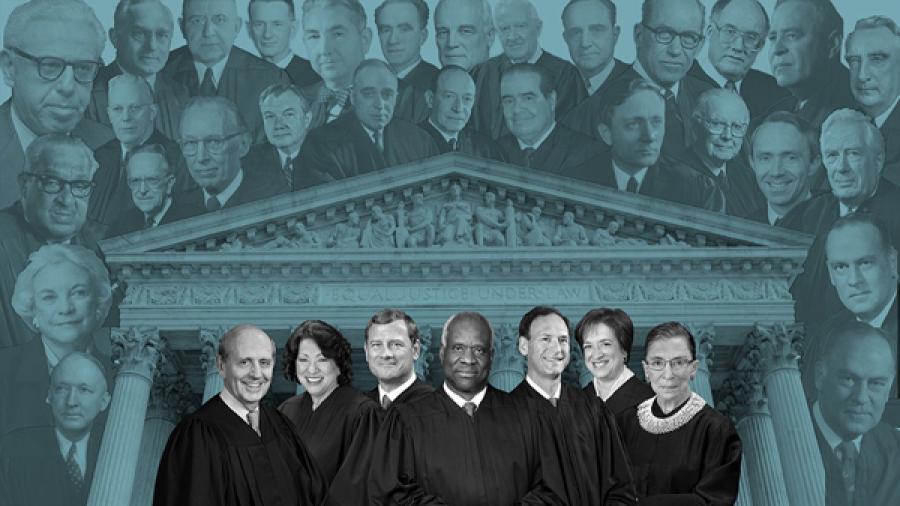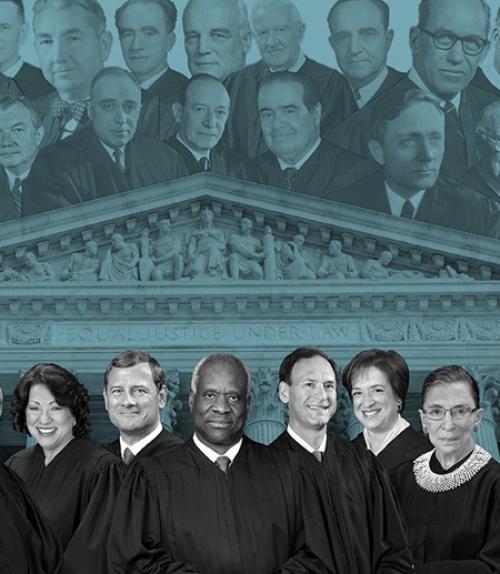The maelstrom surrounding the nomination and subsequent confirmation of Brett Kavanaugh to the Supreme Court was to be expected, when one justice’s vote could change the country’s moral compass for generations. But looking at the high court over a period of decades, have political leanings been its strongest barometer?
No, says Eddie Lee, doctoral student in physics, who applied a statistical physics model for magnetic behavior to a “Super Court” of 36 Supreme Court justices over seven decades. What Lee found was that consensus dominates the court, and strong correlations in voting far outlast any one justice or court.
Unlike congressional politics, where the winds of change can shift every two years, the court is a behemoth with an “institutional timescale” nearly a century long, Lee said.
“Viewing the history of the court through a partisan lens, it doesn’t work,” Lee said. “Actually, a partisan picture breaks down – in fact, any sort of intuitive picture breaks down. … The way the Supreme Court fractures over time, and all the different factions you get, you get a huge number of different blocs all competing to appear.”
Lee’s paper, “Partisan Intuition Belies Strong, Institutional Consensus and Wide Zipf’s Law for Voting Blocs in U.S. Supreme Court,” was published Sept. 14 in the Journal of Statistical Physics.
This research builds on a study Lee finished in 2015, “Statistical Mechanics of the U.S. Supreme Court,” also published in the Journal of Statistical Physics. He and his collaborator built simple models for the distribution of voting patterns and found that, despite ideological differences, a strong tendency toward unanimity emerges from the modeling of the voting record of the second Rehnquist court (1994-2005, total of 895 votes).
Lee revisited the subject last year and expanded his dataset to include a “Super Court” of 36 justices and 24 nine-member courts from 1946 to 2016. Included are seven of the current nine justices; in addition to Kavanaugh, Neil Gorsuch is not included in the study as his term began in 2017.
The modern Supreme Court is generally accepted as beginning in the mid-1940s; the early courts were dominated by unanimity, Lee said. He noted that previous courts – for example, the one presided over by Chief Justice Morrison Waite in the late 1800s – produced 9-0 decisions approximately 90 percent of the time.
While unanimity is nowhere near as prevalent now, it’s still the most frequent outcome – “around 30 to 50 percent” of the time, Lee said. “The fact that there’s consensus on a single Supreme Court is not surprising, but what I did was try to see how people voted across time,” he said.
What he found was that, viewing the court as a singular but ever-changing entity, the court defaults to consensus and strong correlations among justices over time. Long stints in which justices overlap can inform how justices vote relative to each other. In other words, if Justice A and Justice B voted together, and Justices B and C voted together, through transitivity one could infer how Justices A and C would have voted together.
“The way I thought of it was, if I lined all these people up from the present back through the past, how many justices back in time would I have to go to get an independent voice, someone who goes against that unanimous vote,” Lee said. “You’d have to go pretty far back in time, and what I find is that this time, this correlation length, far exceeds the tenure of any single justice.”
Lee sees it as an institutional timescale that emerges from the collection of justices, one that’s not specific to any single justice or any single natural court. “It’s something that spans over time,” he said, “as if it were part of the institution itself.”
Yet this tendency to consensus stands in contrast with another result: Consensus occurs amid a backdrop of shifting alliances. Although the Supreme Court is often thought of in terms of voting blocs (e.g., the unanimous voting bloc or the 5-4 partisan voting blocs), Lee finds that no such simple description typifies voting on the Super Court.
Instead, justices on the Super Court are likely to be in a whole variety of unexpected voting blocs. “No matter what simple picture you prescribe, votes that defy that intuition are probable,” Lee said.
Despite the left-right divide that defines current political debate, he said, the fact that even “partisan issues” are actually much more complicated is reflected in Supreme Court voting over time.
Funding for this work came from the National Science Foundation Graduate Research Fellowship.
This story also appeared in the Cornell Chronicle.





